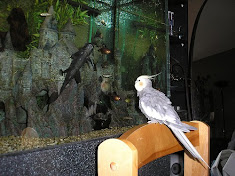When the birds are both healthy and happy in their environment, breeding will take place if steps are not taken to prevent it. It is best to put a mature pair of finches into a cage that is private, as large as possible, provided with nesting places and materials, and that has lots of natural or simulated sunlight.
 |
| Zebra Finch Pair by Ian Bertram |
You will know if the birds are ready to mate by watching the male's dance; he will sing and bounce on the perch to woo his lady. If she is responsive, you need to provide one or more nests, and a selection of nesting materials. Place the nests as high on the cage as possible.
These birds prefer enclosed nests, with a single entrance/exit, and it is a good idea to hang them outside a cage door to save the indoor space for the birds. Dried, chemical-free grass, special breeding cotton, and short strings will be what the male needs as he builds the nest, looking to the female for approval. String must be short or the birds will get tangled in it; no longer than two inch pieces of soft string like unraveled burlap are best.
After the nest is lined, the female will lay an egg a day up to six or eight. If you are using the wicker basket nests, you will have to watch closely to see if the process has started. Wooden box nests with hinged tops make this viewing, and future cleaning, an easy task.
After laying an egg a day for six to eight days, the female will start sitting, with some help from the male in this incubating period. Mark the date down, because the eggs should hatch in 14 days. If they don't hatch within 20 days of the start of incubation, they will not hatch and must be discarded. The female bird will begin the process over a few days after she loses the first clutch. You need to discard the eggs but leave the nest if the lining is clean and dry.
All this time, you must pay particular attention to keeping clean water and fresh seed available, as well as supplementing the grit with calcium-rich oyster shell and hanging up a cuttle bone. Don't forget the long hours of natural or simulated daylight.
After hatching, the young finches will fly in about three weeks and be able to feed themselves after four. They should then be removed to a different cage, since the parents will be starting over with a new family. The male and female should be separated if you don't want more babies. Adjoining cages will allow the pair to see each other for company.
Zebra Finch breeding is easy if the basic rules are followed. Much information and support is available through the National Finch and Softbill Society, based in Tennessee.
Author Resource
Written by Grace Hutchings
Want to find out more about zebra finch breeding, then visit Grace Hutchings's site on how to choose the best pet finch for your needs.



0 comments:
Post a Comment